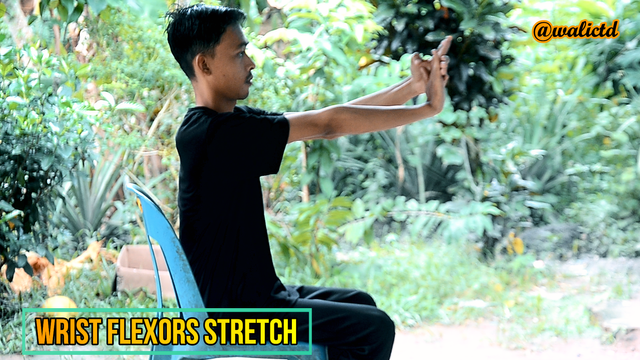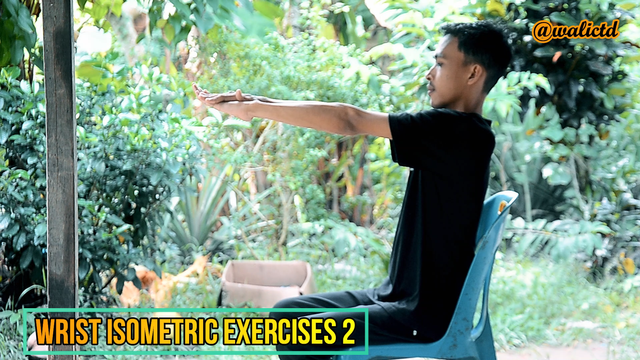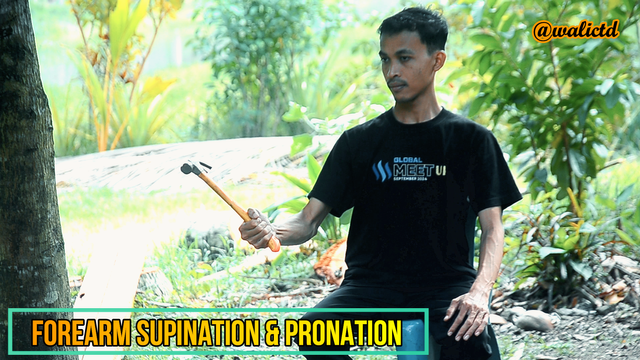Steemit Learning Challenge-S22W5; Golfer's Elbow
Hi friends, after reading around I am interested in participating in an amazing challenge this week. The challenge is titled: "Golfer's Elbow" by @ashkhan following the contest link.
.png) |
|---|
| Previously I also invited other friends such as @ulfatulrahmah, Mr @muzack1 , and Mr @pelon53. |
|---|
In this lesson we were given some tasks to complete, here are some questions and answers from me:

What's a golfer's elbow? Write in your own words after getting knowledge from the lesson post. (Note: don't add special tests or investigations and detailed treatment in this question. Write the answer precisely).
Dear friends, in the first task we will reiterate the explanation of Golfer's Elbow. From the lesson we know that Golfer's Elbow is a condition in which there is inflammation of the tendons around the elbow joint. With the occurrence of this condition, it will certainly cause inflammation of the tendon in the medial part of the elbow. Well, do you know friends, this is what is called medial epicondylitis.
There are 3 types of tissue damage that can be shared based on how severe it is, including tendon rupture, tendinitis and tendonsis. So from here the tendonitis becomes something that causes inflammation around the tendon. This kind of condition is often found in golfers, perhaps because it is caused by hyperflexion of the wrist joint in the hand and elbow.
Like other joint and bone problems, golfer's elbow also has a cause. Among the many, here are some causes that often occur:
- Due to excessive use of the elbow joint even done in a repetitive manner. This kind of condition is often found in golf, which in this kind of sport utilizes a lot of elbow movements in the wrong position, which is the main cause.
- The next cause could be due to trauma or can even be caused by a sudden injury and that certainly occurs in the elbow joint.
- It may also occur due to movement errors in sports such as errors in golfers or the like which certainly use a lot of elbow movement.
- Another common cause can be due to wear and tear which is usually related to agriculture which often utilizes a lot of movement of the shoulder region.
- In addition, there is a history of similar injuries in the past that may cause it to happen again.
- The usual cause of the disease in itself is people with poor ergonomics or posture.
As for the symptoms of Golfer's Elbow, there are many, but the most common ones that can occur in anyone who has been affected by golfer's elbow are: There is pain, especially tenderness on the medial aspect of the affected elbow, there is often swelling when the tendon appears inflammation on the medial side, Patients usually feel tired quickly, perhaps due to the weak strength of the elbow joint due to the joints that support the load being affected, there is also a feeling of numbness in the fingers and wrists that can occur due to muscle weakness and nerve compression and weakening of the range of motion may be due to stiffness in the elbow area & difficulty bending the wrist.
There are 3 types of golfers' elbows, namely: Soft, Medium, and Heavy. When in the soft type category, there is inflammation and irritation in the elbow, but mild pain and stiffness in the elbow joint will at least be an influence to do daily work. When the type is moderate, the Golfer's Elbow patient may experience pain and stiffness at a moderate level, when it is felt in the middle of the elbow which will also affect daily life activities. And finally the Severe type, this type is clearly the most severe condition in golfer's elbow or medial epicondylitis, Golfer's Elbow patients will feel severe pain and stiffness in the elbow, which in this situation makes the sufferer increasingly able to perform daily tasks, such as reducing grip strength.
There are 3 main stages of Golfer's Elbow, all of which affect the duration of the disease. The 3 stages are:
| No | Stage | Condition |
|---|---|---|
| 1 | Acute Stage | In this stage there will be pain and inflammation that may come on suddenly. |
| 2 | Subactivation Stage | In this second stage, it usually occurs less than 1 month after the complete onset of symptoms. |
| 3 | Chronic Stage | In this last stage, it can be said that the most severe stage, can even occur for more than 1 month after passing symptoms such as pain and inflammation. |

How would you diagnose a golfer's elbow? Any clinical investigation or assessment tests? ( Don't add treatment to this question)
Friends, in this second assignment, we will again explain about the diagnosis of Golfer's Elbow. It can be done in a number of ways, but the usual ones include:
- The first step is history taking, which includes ancestry, occupation, and past medical history.
- There will be a full physical examination, which can be done by a doctor or a skilled physical therapist.
- Usually it will also be examined with tools such as X-rays, ultrasound, and MRI. These are all useful to determine the extent of joint inflammation, tendon rupture, and the extent of muscle damage.
- Finally, EMG & NCS will be performed again. The purpose of this is to find out at what level there is damage to the nerves and the level of muscle strength.
In addition, several special tests will usually be carried out to determine the exact diagnosis. Here are some special tests; Medial Epicondyle Test (Which in this test will ask the patient to sit, the elbow is bent 90 degrees fiber tells the patient to straighten the wrist, then pressure is applied to the medial epicondyle, now if there is pain or tenderness then the test is positive), then there is the Cozen Test (In this test also asks the patient to sit while bending the elbow 90 degrees and also straightening the wrist with resistance, at that time if there is pain or tenderness, then the test is also positive), and finally the Valgus Stress Test (Also done when the patient takes a sitting position, but the elbow is supported, at that time the therapist will push the elbow outward, then if the patient will appear pain in the medial epicondyle, then the test is also positive.

Try to practice at least 3 exercises that you have learned from the lesson. Share images, gifs or videos while practicing preferably gifs or videos.
In the material provided by the teacher there are several exercise videos such as : Ball Squeezing, Wrist Flexors Stretch, Wrist Isometric Exercises, and Forearm Supination & Pronation. So on this occasion, let me practice just 3 of these exercises, hopefully in accordance with the recommendations. Here are the videos that I practiced:
- Wrist Flexors Stretch
In this exercise, of course, it is very important to do so that you can increase the length of the muscles that have shortened, as well as the usefulness, which is to compensate for pain. In the video that I have practiced above, where I stretched my wrist flexors with the intention of increasing mobility and flexibility. I also do it in several positions whose duration as suggested in the video is at least 5 seconds or up to 10 seconds.
- Wrist Isometric Exercises
Bagian penting lainnya dari perawatan ini adalah memperkuat setiap otot dan di setiap arah. Oleh karena itu, latihan isometrik dilakukan di berbagai arah untuk memperkuat otot pergelangan tangan dan lengan bawah. Dalam latihan ini, Anda juga menahan posisi dan mencoba menahan sesuai dengan kekuatan otot Anda. Anda harus melakukannya dengan meletakkan tangan di atas meja untuk stabilisasi.
- Forearm Supination & Pronation
In this exercise, of course, it is very easy to do with entry so that you can hold the weight. The exercise may be very necessary because it can strengthen the muscles and also increase the range of motion in our hands. In the video I showed above, where I held the weight in the form of a hammer that I turned slowly.

Share your review after performing these exercises either on yourself, a healthy individual or a patient.
After doing the 3 exercises in task 3, I can say that:
Wrist Flexors Stretch

Honestly, this exercise will definitely help our body in reducing stiffness especially in our wrists and will also increase flexibility for the hands. Some of the movements of this stretch will feel comfortable, more so after activities that use a lot of hands, such as typing in front of a laptop or writing or something like that. For healthy individuals, this kind of exercise is very helpful in preventing muscle tension.Wrist Isometric Exercises

Well, in the second exercise that I have done, it turns out to be very effective in strengthening the strength of the wrist muscles without applying excessive pressure, so it is suitable for healthy individuals and patients who are already included in conditions such as minor injuries, because this exercise is able to provide stabilization without excessive active movements.
- Forearm Supination & Pronation

Finally, When I did this exercise, I found it to be very helpful in working on the mobility of the forearm muscles, as well as helping us to improve range of motion and reduce stiffness in the hand, especially in the wrist and forearm. As for the benefits for healthy individuals, this exercise definitely supports fine motor function and hand coordination.
Thank you for your attention and apologize if there are any mistakes.
@walictd

https://x.com/walictd/status/1879472552806101329
Hi friend, you are absolutely correct that golfer's elbow is a condition caused by inflammation of the tendons located inside the joint. It is caused by repetitive use or overuse of the elbow, especially from activities that involve gripping or wrist movements. The condition causes pain and tenderness in the medial part of the elbow and may cause weakness, stiffness and discomfort when bending the wrist or elbow. Factors such as poor posture, previous injuries or certain sports activities may also contribute to its development.
You have read this course carefully.
Thank you very much sir
Thank you for understanding the lesson and sharing your assignment; I hope that you will enjoy this week's lesson and try to implement it in your life if you see any such case.
Observations
Task 1 (2.8/3)
You have shared a great knowledge about golfer's elbow, its symptoms, causes, types and it's stages. But it would be better to add the name of types given in the lesson post. I appreciate your effort.
Task 2 (3/3)
In the second question, you tell us about how you have to assess a patient by doing physical examination, history taking, and investigations. That's good you add special tests and also explanation of both special tests and investigations. Excellent.
Task 3 (4/4)
You try the forearm supination & pronation, wrist isometrics, and wrist flexors stretch. You did the forearm supination & pronation, wrist isometrics, and wrist flexors stretch correctly. Always remember to apply heat pack in chronic condition and ice pack in acute condition before performing exercises to relax the muscles and reduce stiffness. I appreciate your efforts.
Overall you made a great attempt to answer all the questions. I appreciate your efforts. But next time try to avoid the above written suggestions. Keep learning and try to implement your knowledge to the people suffering from golfer's elbow or any type of elbow issue. Thank you.
Thankyou so much mrs. @ashkhan